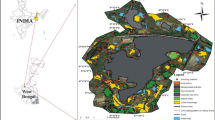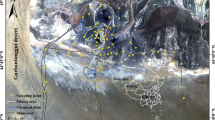Abstract
Purpose
Coal mining activities are inevitably connected with production of acidic drainage and airborne compounds such as fly ash and bottom ash with high metal content. Soil is a prominent sink for trace elements discharged from anthropogenic sources. Thus, understanding the occurrence, accessibility and ecological risk of trace elements around coal mining areas is of utmost importance in view of implications for environmental health.
Materials and methods
Seventy-five soil samples from 25 different sites were collected from Jharia coal field (India) and analyzed for pH, electrical conductivity, total organic carbon, and trace elements. For the background values of trace elements, black shale and sandstone were collected from the study area and analyzed for trace element concentrations. Sampled soils were evaluated for the level of soil contamination with respect to average shale concentrations of toxic trace elements in the region and assessed for their ecological risk in terms of enrichment factor, contamination factor, and pollution load index. Interactions among different trace elements and their spatial distribution were analyzed by the use of multivariate approaches. The study also quantifies the potential sources of contamination for each element and their relation with emission source.
Results and discussion
The average concentrations of Pb, Ni, Cu, Mn, Fe, Zn, and Cd in the soil exceeded the world averages, while Cu and Zn overstepped their respective critical limit in the soil. Enrichment factor values showed that soil near coal mine areas was loaded with Pb, Cd, Cu, Zn, and Ni. The pollution load index and contamination factor suggest that the soils were contaminated by all the investigated trace elements and areas near coal mines were the most polluted. The absolute principal component score technique, combined with multiple linear regression analysis revealed three major factors, coal mining activities/mine fires (40 %), windblown dust (23 %), and crustal (24 %), were responsible for soil trace element pollution in the area.
Conclusions
Coal mining activities, mine fires, and windblown dust are the chief contributors of soil pollution in the area. Coal mining activities/mine fires are the main contributing sources to soil Ni, Cu, and Cr, while crustal input was mainly represented by Mn and Zn and windblown dust for Pb, Fe, and Cd. High concentrations of trace elements at any site depend on the feasibility and availability of respective pollution sources.




Similar content being viewed by others
References
Allison LE (1986) Organic carbon part I. In: Klute A (ed) Methods of Soil Analysis. American Society of Agronomy, Madison, pp 1367–1381
Alloway BJ (2013) Sources of heavy metals and metalloids in soils. In: Alloway BJ (ed) Heavy metals in soil. Springer, Dordrecht, pp 11–50
Banerjee NN (2000) Trace metals on Indian coals. Allied Publishers, pp 4-8
Bhuiyan MAH, Parvez L, Islam MA, Dampare SB, Suzuki S (2010) Heavy metal pollution of coal mine-affected agricultural soils in the northern part of Bangladesh. J Hazard Mater 173:384–392
Buat-Menard P, Chesselet R (1979) Variable influence of the atmospheric flux on the trace metal chemistry of oceanic suspended matter. Earth Planet Sc Lett 42:399–411
Chen H, Laskin A, Baltrusaitis J, Gorski CA, Scherer MM, Grassian VH (2012) Coal fly ash as a source of iron in atmospheric dust. Environ Sci Technol 46:2112–2120
Dantu S (2009) Heavy metals concentration in soils of southeastern part of Ranga Reddy district, Andhra Pradesh, India. Environ Monit Assess 149:213–222
Dhal B, Thatoi HN, Das NN, Pandey BD (2013) Chemical and microbial remediation of hexavalent chromium from contaminated soil and mining/metallurgical solid waste: a review. J Hazard Mater 250:272–291
Dong J, Yang QW, Sun LN, Zeng Q, Liu SJ, Pan J, Liu XL (2011) Assessing the concentration and potential dietary risk of heavy metals in vegetables at a Pb/Zn mine site, China. Environ Earth Sci 64:1317–1321
Dubey B, Asim PK, Singh G (2012) Trace metal composition of airborne particulate matter in the coal mining and non–mining areas of Dhanbad Region, Jharkhand, India. Atmos Pol Res 3:238–246
Facchinelli A, Sacchi E, Mallen L (2001) Multivariate statistical and GIS -based approach to identify heavy metal sources in soil. Environ Pollut 114:313–324
Gaidajis G (2003) Ambient concentrations of total suspended particulate matter and its elemental constituents at the wider area of the mining facilities of TVX Hellas in Chalkidiki, Greece. J Environ Sci Heal A 38:2509–2520
Ghose MK, Majee SR (2007) Characteristics of hazardous airborne dust around an Indian surface coal mining area. Environ Monit Assess 130:17–25
Gonzalez-Macias A, Schifter I, Lluch-Cota DB, Mendez-Rodriguez L, Hernandez-Vazquez S (2006) Distribution, enrichment and accumulation of heavy metals in coastal sediments of Salina Cruz Bay, Mexico. Environ Monit Assess 118:211–230
Gowd SS, Reddy MR, Govil PK (2010) Assessment of heavy metal contamination in soils at Jajmau (Kanpur) and Unnao industrial areas of the Ganga Plain, Uttar Pradesh, India. J Hazard Mater 174:113–121
Hakanson L (1980) An ecological risk index for aquatic pollution control. A sedimentological approach. Water Res 14:975–1001
Hu Y, Cheng H (2013) Application of stochastic models in identification and apportionment of heavy metal pollution sources in the surface soils of a large-scale region. Environ Sci Technol 47:3752–3760
Kabata-Pendias A (2010) Trace elements in soils and plants, 3rd edn. Taylor & Francis
Key M (2012) A tutorial in displaying mass spectrometry-based proteomic data using heat maps. 13. BMC Bioinformatics 13:S10
Li WH, Tian YZ, Shi GL, Guo CS, Li X, Feng YC (2012) Concentrations and sources of PAHs in surface sediments of the Fenhe reservoir and watershed, China. Ecotox Environ Safe 75:198–206
Li Z, Ma Z, Van der Kuijp TJ, Yuan Z, Huang L (2014) A review of soil heavy metal pollution from mines in China: pollution and health risk assessment. Sci Total Environ 468:843–853
Mahowald NM, Baker AR, Bergametti G, Brooks N, Duce RA, Jickells TD, Kubilay N, Prospero JM, Tegen I (2005) Atmospheric global dust cycle and iron inputs to the ocean. Global Biogeochem Cy 19, GB4025
Masto RE, Ram LC, George J, Selvi VA, Sinha AK, Verma SK, Rout TK, Priyadarshini, Prabal P (2011) Impacts of opencast coal mine and mine fire on the trace elements content of the surrounding soil vis-à-vis human health risk. Toxicol Environ Chem 93:223–237
Oorts K (2013) Key heavy metals and metalloids. In: Alloway BJ (ed) Heavy metals in soil. Springer, Dordrecht, pp 367–394
Pandey B, Agrawal M, Singh S (2014) Assessment of air pollution around coal mining area: emphasizing on spatial distributions, seasonal variations and heavy metals, using cluster and principal component analysis. Atmos Pol Res 5:79–86
Qu MK, Li WD, Zhang CR, Wang SQ, Yang Y, He LY (2013) Source apportionment of heavy metals in soils using multivariate statistics and geostatistics. Pedosphere 23:437–444
Rout TK, Masto RE, Ram LC, George J, Padhy PK (2013) Assessment of human health risks from heavy metals in outdoor dust samples in a coal mining area. Environ Geochem Health 35:347–356
Rout TK, Masto RE, Padhy PK, George J, Ram LC, Maity S (2014) Dust fall and elemental flux in a coal mining area. J Geochem Explor 144:443–455
Schaefer K, Einax JW, Simeonov V, Tsakovski S (2010) Geostatistical and multivariate statistical analysis of heavily and manifoldly contaminated soil samples. Anal Bioanal Chem 396:2675–2683
Sebestova E, Machovic V, Pavlikova H, Lelak J, Minarik L (1996) Environmental impact of brown coal mining in Sokolovo basin with especially trace metal mobility. J Environ Sci Heal A 31:2453–2463
Sharma RK, Agrawal M, Marshall F (2007) Heavy metal contamination of soil and vegetables in suburban areas of Varanasi, India. Ecotox Environ Safe 66:258–266
Shi GL, Li X, Feng YC, Wang YQ, Wu JH, Li J, Zhu T (2009) Combined source apportionment, using positive matrix factorization-chemical mass balance and principal component analysis/multiple linear regression-chemical mass balance models. Atmos Environ 43:2929–2937
Singh AK (2011) Elemental chemistry and geochemical partitioning of heavy metals in road dust from Dhanbad and Bokaro regions, India. Environ Earth Sci 62:1447–1459
Singh AK, Mondal GC, Singh TB, Singh S, Tewary BK, Sinha A (2012) Hydrogeochemical processes and quality assessment of groundwater in Dumka and Jamtara districts, Jharkhand, India. Environ Earth Sci 67:2175–2191
Singh AK, Sharma M, Singh MP (2013) SEM and reflected light petrography: a case study on natural cokes from seam XIV, Jharia coalfield, India. Fuel 112:502–512
Smolders E, Mertens J (2013) Key heavy metals and metalloids. In: Alloway BJ (ed) Heavy metals in soil. Springer, Dordrecht, pp 283–312
Tang WW, Zeng GM, Gong JL, Liang J, Xu P, Zhang C, Huang BB (2014) Impact of humic/fulvic acid on the removal of heavy metals from aqueous solutions using nanomaterials: a review. Sci Total Environ 468:1014–1027
Thurston GD, Spengler JD (1985) A quantitative assessment of source contributions to inhalable particulate matter pollution in metropolitan Boston. Atmos Environ 19:9–25
Tian HZ, Lu L, Cheng K, Hao JM, Zhao D, Wang Y, Jia WX, Qiu PP (2012) Anthropogenic atmospheric nickel emissions and its distribution characteristics in China. Sci Total Environ 417:148–157
Tomlinson DL, Wilson JG, Harris CR, Jeffrey DW (1980) Problems in the assessment of heavy-metal levels in estuaries and the formation of a pollution index. Helgol Meeresunters 33:566–575
Twardowska I, Kyziol J (2003) Sorption of metals onto natural organic matter as a function of complexation and adsorbent–adsorbate contact mode. Environ Int 28:783–791
Usman ARA (2008) The relative adsorption selectivities of Pb, Cu, Zn, Cd and Ni by soils developed on shale in New Valley, Egypt. Geoderma 144:334–343
Varol M (2011) Assessment of heavy metal contamination in sediments of the Tigris River (Turkey) using pollution indices and multivariate statistical techniques. J Hazard Mater 195:355–364
Wentzell PD, Andrews DT, Hamilton DC, Faber K, Kowalski BR (1997) Maximum likelihood principal component analysis. J Chemometrics 11(4):339–366
World Coal Association, Coal Facts (2011) http://www.worldcoal.org/resources/coal statistics. Accessed in 29 April 2012
Young SD (2013) Chemistry of heavy metals and metalloids in Soils. In: Alloway BJ (ed) Heavy metals in soil. Springer, Dordrecht, pp 51–96
Zhang W, Feng H, Chang J, Qu J, Xie H, Yu L (2009) Heavy metal contamination in surface sediments of Yangtze River intertidal zone: An assessment from different indexes. Environ Pollut 157:1533–1543
Zsefer P, Glasby GP, Sefer K, Pempkowiak J, Kaliszan R (1996) Heavy-metal pollution in superficial sediments from the southern Baltic Sea off Poland. J Environ Sci Health A 31:2723–2754
Acknowledgments
We thank the head of the Department of Botany, Banaras Hindu University, and Director, Central Institute of Mining and Fuel Research, Dhanbad, for providing all the necessary laboratory facilities during the research work. Financial assistance in the form of a research project (EE/39) funded by Ministry of coal, Government of India, New Delhi is also acknowledged. We are also thankful to anonymous reviewers for critically examining the manuscript and for providing the useful suggestions which immensely helped in improving the quality of the manuscript.
Author information
Authors and Affiliations
Corresponding author
Additional information
Responsible editor: Jianming Xu
Electronic supplementary material
Below is the link to the electronic supplementary material.
ESM 1
(DOCX 266 kb)
Rights and permissions
About this article
Cite this article
Pandey, B., Agrawal, M. & Singh, S. Ecological risk assessment of soil contamination by trace elements around coal mining area. J Soils Sediments 16, 159–168 (2016). https://doi.org/10.1007/s11368-015-1173-8
Received:
Accepted:
Published:
Issue Date:
DOI: https://doi.org/10.1007/s11368-015-1173-8




